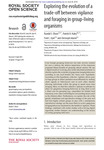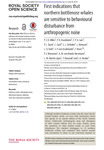Search
Now showing items 31-40 of 113
Carry over bodymass effect from winter to breeding in a resident seabird, the little penguin
(The Royal Society, 2015)
Using body mass and breeding data of individual penguins collected continuously over 7 years (2002–2008), we examined carry-over effects of winter body mass on timing of laying and breeding success in a resident seabird, ...
Female signalling tomale song in the domestic canary, serinus canaria
(The Royal Society, 2015)
Most studies on sexual selection focus on male characteristics such as male song in songbirds. Yet female vocalizations in songbirds are growing in interest among behavioural and evolutionary biologists because these ...
Kin selection and polygyny: can relatedness lower the polygyny threshold?
(The Royal Society, 2015)
Resources for female breeders. When breeding with a relative, however, such costs may be lessened by indirect fitness benefits through kin selection, while benefits from mutualistic behaviour, such as communal defence, may ...
Exploring the evolution of a trade off between vigilance and foraging in group living organisms
(The Royal Society, 2015)
Even though grouping behaviour has been actively studied for over a century, the relative importance of the numerous proposed fitness benefits of grouping remain unclear. We use a digital model of evolving prey under ...
Eye spots in Lepidoptera attract attention in humans
(The Royal Society, 2015)
Many prey species exhibit defensive traits to decrease their chances of predation. Conspicuous eye-spots, concentric rings of contrasting colours, are one type of defensive trait that some species exhibit to deter predators. ...
First indications that northern bottlenose whales are sensitive to behavioural disturbance from anthropogenic noise
(The Royal Society, 2015)
Although northern bottlenose whales were the most heavily hunted beaked whale, we have little information about this species in its remote habitat of the North Atlantic Ocean. Underwater anthropogenic noise and disruption ...
Position dependent hearing in three species of bushcrickets
(The Royal Society, 2015)
A primary task of auditory systems is the localization of sound sources in space. Sound source localization in azimuth is usually based on temporal or intensity differences of sounds between the bilaterally arranged ears. ...
Consistent individual differences in haemolymph density reflect risk propensity in amarine invertebrate
(The Royal Society, 2015)
While the literature on consistent individual differences in correlated suites of physiological and behavioural traits is steadily growing for vertebrates, invertebrates have received less attention. The few studies that ...
Brain nonapeptide levels are related to social status and affiliative behaviour in a cooperatively breeding cichlid fish
(The Royal Society, 2015)
The mammalian nonapeptide hormones, vasopressin and oxytocin, are known to be potent regulators of social behaviour. Teleost fishes possess vasopressin and oxytocin homologues known as arginine vasotocin (AVT) and isotocin ...
Wind plays a significant role in the flight altitudes selected by nocturnally migrating birds. At mid-latitudes in the Northern Hemisphere, atmospheric conditions are dictated by the polar-front jet stream, whose amplitude increases in the autumn. One consequence for migratory birds is that the region’s prevailing westerly winds become progressively stronger at higher migration altitudes
(The Royal Society, 2015)
Seasonal changes in the altitudinal distribution of nocturnallymigrating birds during autumnmigration.










